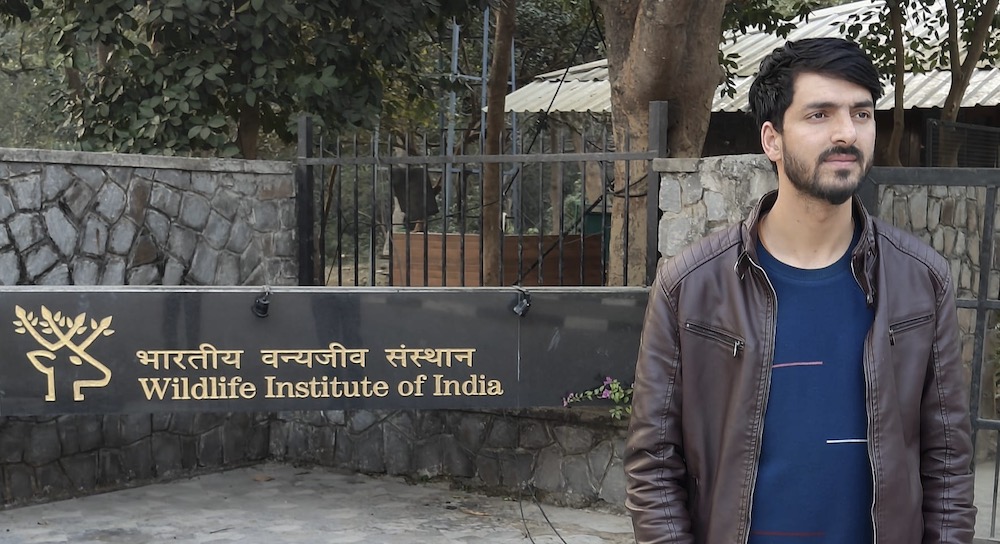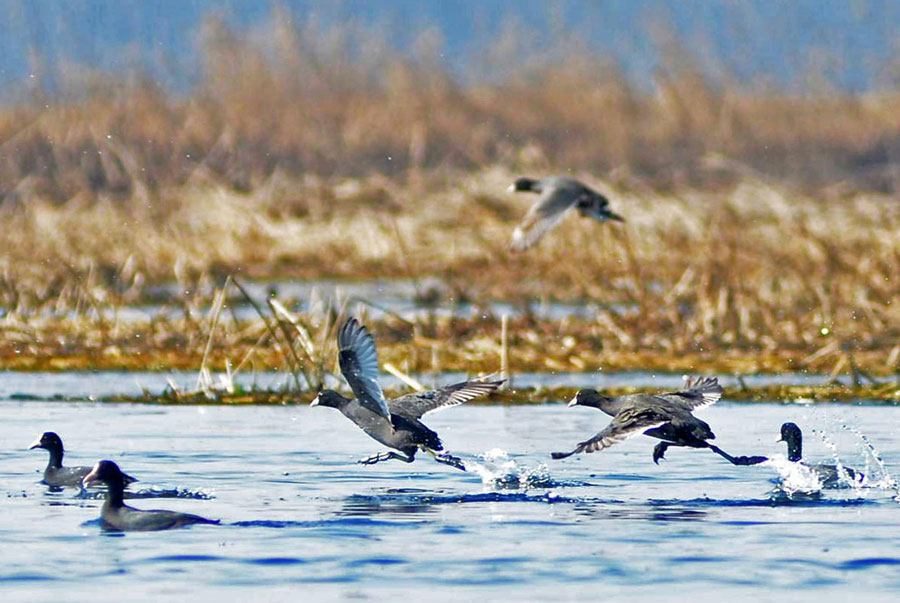Living with birds that co-exist in the surroundings of a South Kashmir wetland made Parvaiz Yousuf curious about avian life in Kashmir. Now he has a master’s in Zoology and is keen to get into research about the birds. Days after his compilation of the bird species was published, the young ornithologist talked to Khalid Bashir Gura
In Kashmir’s saffron town Pampore at Lalpora, nestling on the banks of Chatlam Wetland Reserve, Parvaiz Yousuf, 25, opens the room window to catch the sight of his constant companions – the birds. Their orchestra and fluttering of wings would instil in him curiosity about the avian life.
Why do bulky Greylag gooses fly in V-shapes in the sky? Why crow, myna, sparrows, kites, Mallard Pachen, Cinereous tit Rang e tcxir, Tickell’s thrush Kastoor, blue-whistling thrush Hazardastan, Yellow-billed blue magpie Laetraaz, Eurasian sparrow-hawk Varyul, long-tailed shrike Haarwatij, streaked-laughing thrush Shin e pipin’ are deeply embedded in Kashmir culture? Why do some people dread owl’s hoot and sell their nails for black magic?
Kashmir seasons are linked to certain birds. When barn swallows (Katij) arrive, spring is around and when migratory birds land, winter takes off.
Since childhood, these curiosities were a perpetual hangover on Yousuf. He gradually discovered the intricate linkage of avian life with human life. “Many birds are pollinators, fundamental to our food security. Some species feed on insects and pests and protect our crops,” Yousuf said. “Vultures are natural scavengers and manage carcasses. Many birds help make forests by dispersing seeds throughout different places in their poops.”
This was precisely why he chose ornithology as his subject of passion and career. “I decided to pursue a degree and dedicate my life in the same field,” Yousuf said. “Earth belongs to them as it belongs to us.”
Education
Yousuf enrolled in an integrated 5-year Bachelor and Masters Course in Zoology at Central University of Kashmir, which equipped him with the technical knowledge about birds. Simultaneously, he joined the Wildlife Conservation Fund (WCF) as a volunteer in 2017. A year later, he became its chief coordinator and later Director of Wetland Research Centre, where he headed a 19-member team.
“WCF equipped me with many basic resources as an ornithologist. I started monitoring birds in Pampore wetlands, contributed in conducting Asian Water Birds census by JK wildlife department,” Yousuf said. It enabled him to move beyond Pampore. “I recently completed my degree in 2022 and also qualified for the National Eligibility Test (NET).” He was trained in ornithology under the Green Skill Development Programme (GSDP) of the Ministry of Environment, Forest and Climate Change.

An Author
An avid bird watcher and a student of citizen science since 2017, he would observe birds across Kashmir, deliver guest lectures at schools and colleges and, as a guide, take school kids to different wetlands and national parks. The student’s questions during these interactions gave birth to his book.
In October 2022, when the Tourism Department organised its first bird festival at Pahalgam, students asked him if there was a book on birds from Kashmir. “With all the data compiled in the previous years, I started working on a book and it was ready in a year,” he said.
Published by the Wular Publishing House, Birds of Jammu and Kashmir Including Ladakh, is the first of its kind on Kashmir’s avian life. Containing more than 2000 coloured pictures of all male, female, juvenile, breeding and non-breeding bird species, the book serves as a baseline for bird watchers and researchers. “I have included scientific names, common English names, bird families and vernacular names in Kashmir, Dogri and Ladakhi (wherever known), distribution, size, IUCN status and short bird descriptions,” Yousuf said. “It also provides detailed information on Important Bird Areas (IBA’s), bird topography and the number of threatened birds.”
The book, an outcome of fieldwork and literature search, attempts to make a distinction between highly cryptic bird species which may appear similar to laymen. The photographs in the book have been contributed by many bird lovers.
Bird Diversity
Yusuf said, that Jammu and Kashmir, Ladakh fall in North-western and trans-Himalayas and are very rich in bird diversity. This diversity is attributed to the different agro-climatic spaces of these regions – a temperate Kashmir; a subtropical Jammu and the cold desert of Ladakh. A total of 677 bird species are found in Jammu and Kashmir as per the book and a research paper published in 2023 in Nusantara Bioscience.
“Out of those, Kashmir has 555 bird species, while keeping in mind that most species overlap in these three regions as birds are migratory,” Yousuf said. “Indian subcontinent has around 1372 bird species.” Nearly half of the bird species found across Indian subcontinents are found in Jammu Kashmir and Ladakh.
Kashmir has too many birding areas. For migratory birds, Pampore wetlands, Wular, Hokersar, and Shalbugh, are great choices. For terrestrial birds, Dachigam National Park, Kangan, Yusmarg, Pahalgam, and Uri are preferred spaces.

Endangered Birds
As many as 54 bird species are threatened in erstwhile Jammu and Kashmir. These include Western Tragapon, Cheer pheasant, long-tailed duck, white-headed duck, Egyptian vulture, Steppe eagle, Tawny eagle, and Kashmir flycatcher.
Birds in the rare list include Kashmir Flycatcher, Spectacled Finch, Western Tragopan, Cheer Pheasant Brook’s Leaf Warbler, Tytler’sLeaf Warbler, White-throated Tit, Kashmir Nuthatch and Orange Bullfinch, Kashmir nutcracker. Off late, house sparrows, and barn swallows are rarely sighted. Yousuf attributes it to changing architecture.
“The construction of cemented houses has rendered them homeless. “These bird species used to find a haven in old mud houses where they would make nests and hide from predators in crevices,” Yousuf said. “Now our homes are concrete lacking any entry to any bird, not even in attics. Besides noise and light pollution is impacting them.”
Unlike Barn swallows, some less sensitive birds like mynas are least affected as they nest over trees.
“Ibisbill, a beautiful bird species feeds and breeds in the shallow stony river beds in places like Kangan, and Pahalgam,” Yousuf said. “But unchecked dredging for boulders is destroying their breeding and feeding space.” He said climate change may have had an impact as well but there is no significant study.
Eco-tourism
Yousuf believes Kashmir has huge ecotourism potential. Many bird species are endemic to Kashmir, so bird lovers, researchers or photographers interested in seeing birds such as Spectacled finch, and Orange bullfinch come to Kashmir and promote ecotourism.
“We receive tens of thousands of migratory bird species, and many people are flying to see the spectacle,” he said, insisting it invariably provides employment. Birding is a stress buster. “You get connected to nature at a deeper level. Your eyes, ears, and overall senses become shaped. It helps humans to understand nature and bird behaviour better.”
However, Yousuf pointed out that Kashmir lags in avian research. “Not much of avian research has been done in the region,” he said, asserting his book is perhaps the first of its kind that documents the bird diversity. “No particular species-centric research has been conducted which would help frame conservation plan for such bird species.”
“My book is my first contribution. I have authored many research papers about new bird sightings in Kashmir as well. All these things will help create a baseline data for future researchers in Kashmir,” Yusuf said.














